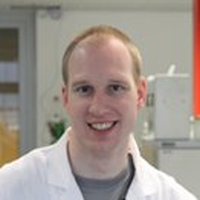Scattering Gold Particles
Strategies for ultra sensitive DNA detection
Promotion date: 5. September 2012
Promotor: Prof. dr. Vinod Subramaniam
Assistant promotor: Dr. Rob Kooyman
| This thesis describes the development of a novel biosensor, based on scattering gold nanoparticles, from a theoretical idea on paper to a working sensor system which is sensitive for specific DNA detection in the femtomolar range. The light scattering and absorption properties of gold particles can be utilized for the detection of DNA. Binding of molecules to the gold particles influences the local refractive index. The increase in refractive index can be measured as a proportional red-shift. The modification chemistry needed, and theoretical simulations involved, are described to provide insight into the reported sensing method and experimental setup. Utilizing this approach it is possible to detect DNA in naturally occurring quantities. In total five different DNA detection assays were investigated. |
Can you specify the advantages of the method used?
The method involves DNA attached to specially prepared gold nanoparticles. The detection principle is based on surface Plasmon resonance (SPR), which nowadays is a common used method for protein interaction analysis.
For each individual gold particle the effect of SPR can be monitored in a local area directly around the particle. This effect changes by modifying the refractive index in this local area, and the response can be observed as a change in scattering color. Using nothing more than a conventional dark field microscope with color camera and analysis software, the scattering of the particles can be used for the detection of single binding events.
For low concentrations we designed an amplifying strategy using two kinds of gold particles, differing in size. After showing convincingly the detection method was valid, in the last chapters we made suggestions to further improvement, clearly showing the potential of this technique.
The method is suitable for detecting illness-makers like tuberculoses. Also the technique is more quantitative in comparison to quantitative polymerase chain reaction (qPCR), commonly used.
However, different biochemical processes still are in need of optimization steps. Imagine, DNA-strands have to be attached to the gold particles, stay there and remain functional, i.c. being able to bind to the complementary DNA and, after that, preferably to other functionalized gold particles. The results are very promising, which led to further research in a new PhD-project subsidized by NWO.
Was there a special moment that you recall, during your PhD period?
Coming to a flow-cell which is easy to fabricate and fits in a standard microscope using pre-modified glass slides with gold nanoparticles, was a major step.
On this road many obstacles had to be passed by solving many biochemical problems such as: immobilization of the DNA-receptors to the gold particles; immobilization of gold particles on their surface; and surface modifications and assay condition optimizations to increase immobilization yield.
One of the fundamental problems was the fact that DNA is negatively charged, as are the gold particles. Therefore, binding was not a stable situation. By adding a soap-like solution and salt, the DNA strands found the gold particles and bound, going through the soap layer.
When I was able to prove without doubt the DNA was firmly attached to the gold particles, and also this DNA was active to make reactions to DNA-strands in solution, the basics of my sensor idea were there, giving me a boost to further analyses.
In what way did you develop as a researcher and scientist during the project?
Coming from a practical professional background as an analyst, helped me a great deal. Here I learned to work properly, following a well-defined, preset path of experimentation actions.
In the PhD project I learned to include theoretical input into my workflow, incorporating these considerations into the experimentation strategies. By doing so, my research is performed more efficiently now and I understand much better what I am about to do.
However, biochemical processes are inconstant by nature. Experimentation and simulations will always be a major part of the work.
What are your future plans?
Right now I am working as a post-doc at the University of Amsterdam. Here I develop sensors for specialized research using Atomic Force Microscopy. Using lithography techniques to prepare sensor structures on the tip of a glass fiber I can enable mass production. These sensors can be build adding cantilever functionalization and special coatings making biochemical or force interaction measurements possible.
A spin-off company is established, coming from this research. I would like to be part of them, designing new sensors and measurement strategies.
What in your opinion is important for Mesa+ to stay successful in future?
I was a researcher, half at the Mesa+ institute and half at the Mira institute, working between biophysics and nanotechnology.
It is great to have so many knowledge areas at your disposal, for example lithography techniques to fabricate flow cells and highly sophisticated microscopy techniques. Using these, I could visually confirm gold nanoparticles were bound together. Therefore my approach was really working.
Fundamental research and application oriented research can very well go together, I believe. Fundamental research can be inspired by questions coming from companies or from the community. This is important, especially when a lot of tax money is involved. Mesa+ continually has to find new ways to make the research visible and understandable for a broad audience. And, of course, to show its applicability.

